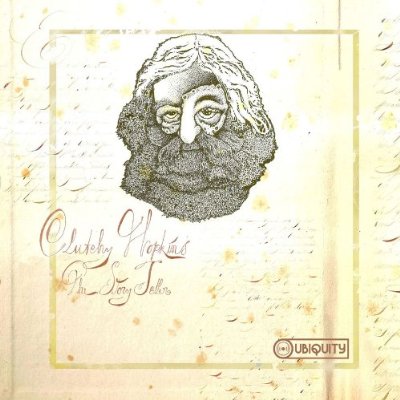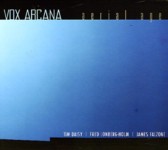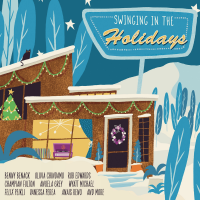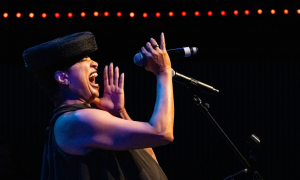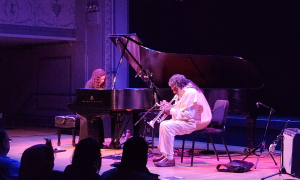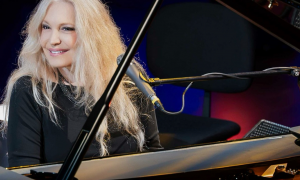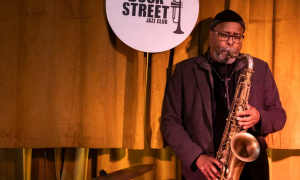Home » Jazz Articles » Live Review » Vision Festival 2010: Day 2, June 24, 2010
Vision Festival 2010: Day 2, June 24, 2010
Muhal Richard Abrams, Joseph Jarman, John Tchicai
Vision Festival
Abrons Arts Center
New York City
June 24, 2010
Never has the Vision Festival tradition of honoring the lifetime achievement of seminal figures in the avant jazz world seemed more timely. In an eight-day period, which saw the passing of previous honorees Bill Dixon and Fred Anderson, the award for Chicago AACM founder Muhal Richard Abrams was spectacularly apt. News of Anderson's death in the small hours of the morning drew an audible gasp from festival-goers who had been hoping that the 81-year old saxophonist might have recovered from his illness sufficiently to make his scheduled appearance in duet with drummer Chad Taylor during the evening's celebrations.
While inevitably tinged with sadness, proceedings were nonetheless joyful in acknowledging Abrams' massive contribution to the music, and there was a sizeable cohort of friends in attendance to honor the pianist. Abrams both commenced and finished the program, appearing solo initially, in a set dedicated to Anderson, and concluding with a trio. In between was a set by fellow AACM member Joseph Jarman with a surprise special guest.
Abrams' first gigs were playing the blues, R&B, and hard bop circuit in Chicago and working as a sideman with everyone from Dexter Gordon and Max Roach to Sonny Stitt and Woody Shaw. But in 1961, Abrams instituted the Experimental Band, a group that eventually blossomed into the hugely influential AACM. Founded in 1965 by Abrams, Steve McCall, Jodie Christian, and Phil Cohran, the still-extant Association for the Advancement of Creative Musicians is "a collective of musicians and composers dedicated to nurturing, performing, and recording serious, original music," according to its website. George Lewis authoritative tome A Power Stronger Than Itself (University of Chicago Press, 2008) gives the lowdown on the organization from one who was there and is particularly insightful on Abrams role within it.
Their creative ethos was summed up by Abrams in a recent interview. He said: "Everything counts. Your whole experience counts. It comes to a sum total at any point in your existence. Tomorrow, there'll be another sum total, because the thing that happens today will be added to tomorrow. As long as you're here in a physical existence, practicing the craft, then it's a constantly changing proposition. You learn something new every day. And that process has not changed as far as my procedures have been going. It's pretty much a constant book of changes."
Chapter Index
Muhal Richard Abrams Solo
Though Abrams has composed for everything from duos to big band, by way of string quartets, he claims that the extemporaneous solo performance, which draws on his full wellspring of experience and intuition, is the pinnacle of his art. If so, we were among the highest peaks tonight.
 Muhal Richard Abrams
Muhal Richard AbramsStarting with a resonant pealing chord, Abrams sat otherwise motionless at the keyboard. Whether because of the occasion or not it was an emotionally charged event, with a palpable sense of purpose apparent in its unhurried construction. Ringing dissonances in the bass extremities acted as a recurring motif for the opening section, sometimes thickened into elongated tendrils of notes, at others extended in a sustained clanging passage with overtones zinging round the hall. At the core was a whirling kaleidoscopic two handed exposition, fusing jazz, classical, and trance music into a deeply personal whole.
Though there were traces of melody, Abram's aesthetic was more about the investigation of sound and reverberation, unfurled in continuous unbroken waves for all but the beginning and the end. As the piece progressed, Abrams transitioned into more open territory, with tinkling tremolos and sudden arpeggios storming down into the bass register. He pitched a stream of hammered single notes against left hand runs, before an elegant figure fleetingly emerged, interpolated with some broken stride.
Finally, a rippling left hand figure gave way to a solitary tolling note, both foreboding and foretelling, which mirrored the opening gambit and confirmed a supreme awareness of structure. Overall there was a ferocious focus to Abrams expression, maintaining a somber mood without being funereal. A deserved standing ovation erupted for a masterly performance, unforgettable for those present, and one of the high points of the Festival.
Fred Anderson was supposed to follow next. Organizer Patricia Nicholson explained that rather than make a last minute change to the schedule, there would be a prolonged break before the next set, preceded by ten minutes of silent remembrance.
Joseph Jarman Lifetime Trio
Jarman's trio with Rob Garcia on drums and John Ehlis on guitar combined for a brace of typically light airy confections, familiar to anyone who has seen Jarman of late, mixing sometimes querulous vocals and exotic percussion with fine melodic playing and a loose swing. Jarman's alto saxophone solos sporadically gave inklings of his fire-breathing days in the Art Ensemble Of Chicago, but even when ascending to a climax of false fingered squeals, he swiftly cooled for another tuneful theme. Ehlis showed himself to be especially adept at bright singing guitar solos, while Garcia spun his one feature engagingly from the thematic fabric.
 From left: John Tchicai, Rob Garcia, Joseph Jarman
From left: John Tchicai, Rob Garcia, Joseph JarmanPartway through a duet of Jarman's flute and Ehlis' wood flute, a gruff saxophone honk drifted from the wings. Jarman gestured and the invisible reedman was revealed as the legendary John Tchicai, who moved onto the stage to initiate musical dialogue with Jarman. Taking his customary route of heaping repeated motifs one atop another until reaching paroxysms of guttural distortion, Tchicai ratcheted up the intensity to fierce drum accompaniment. An impromptu arrangement emerged as the highlight of the set. Guitar and drums twinned in a relaxed calypso rhythm, over which Tchicai extemporized melody, picked up and sung wordlessly by Ehlis. Jarman blended in his alto, intertwining with the tenor for a glorious sequence of ricocheting reed aerobatics. As Jarman and Garcia together became more fractious, Tchicai echoed Jarman's phrases, before the drums dropped out leaving the two horns to close out a perfect ending, all the more pleasing for being spontaneous and unrehearsed.
Muhal Richard Abrams Trio
For the final set of the evening Abrams returned with fellow Chicagoans Ari Brown and Harrison Bankhead. Their performance broached similarly challenging terrain in its lack of familiar stylistic reference points and made as few concessions as the pianist's solo triumph. Brown's tenor saxophone began in probing spiritual vein, before bassist Bankhead and Abrams joined in spacious counterpoint. There was a conversational quality to the group's discourse, like a three-way call and response. Closest in Abrams discography in terms of feel, though with different collaborators, would be the improvised trio Streaming (Pi, 2006).
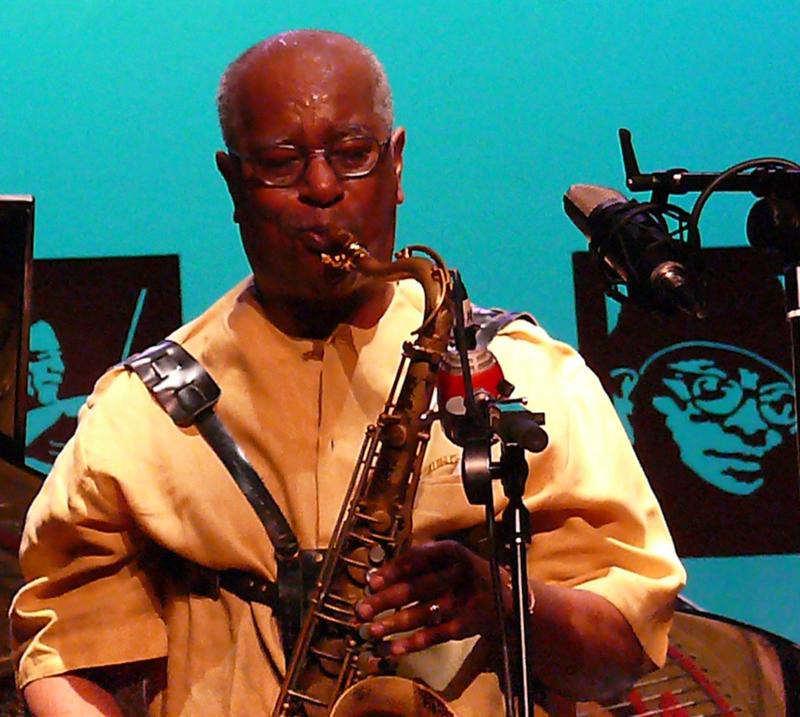 Ari Brown
Ari BrownAbrams proved himself an egalitarian leader: there was no composed or preconceived material, and changes and transitions seemed equally likely to be initiated by any of the participants. The only time when Abrams did explicitly take the lead was in establishing some of the faster most animated sections from his keyboard. None of the instruments fulfilled their conventional roles in a jazz trio. While there was flow and narrative thrust, it was derived from the artful accumulation of instrumental color rather than swing, harmony or steady meter, with animation coming in fits and starts. Was it jazz? Does it matter? As with much of Abrams oeuvre it was beyond classification.
Brown demonstrated his mastery of the darker saxophonic arts without fanfare; casually tempering what initially sounded straightforward blowing with discordant edges, growling multiphonics and singing through his horn. Bankhead likewise covered the extremes of his axe: whether soaring into the cello range, bouncing the bow off his strings for rhythmic emphasis, or one time bowing the equivalent of a tuba "oompah" line. Abrams himself played more sparsely than during his solo, content to catalyze and pontificate without needing to assume sole responsibility for creating impetus. Listening was at a high level though responses were rarely obvious and often bordered on the oblique. But having grown to expect dislocation, Brown showed that even this shouldn't be taken for granted by echoing Abrams phrasing as a pushing off point for his own further exploration.
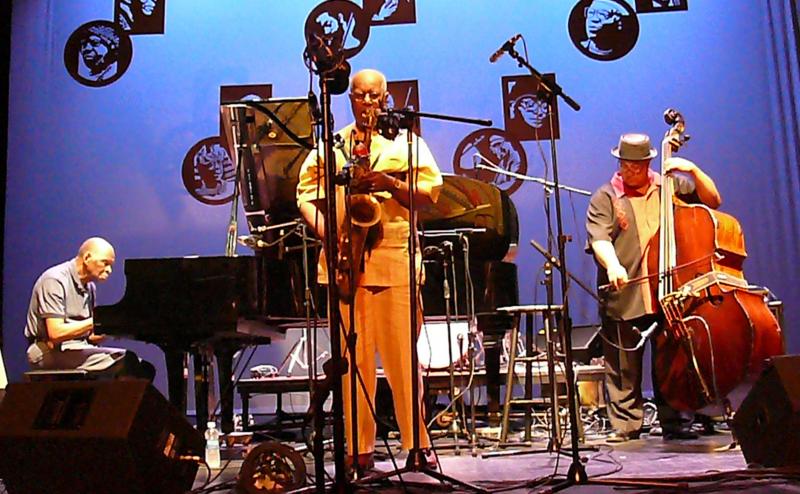 Muhal Richard Abrams Trio
Muhal Richard Abrams TrioFurther confluence occurred towards the end of their time as Abrams hinted at an attractive melody, which was reflected by Brown, with Bankhead slipping into tempo. And yet just as it appeared a prearranged ending was imminent, they edged again into more abstract realms before an eventual more understated close. Nonetheless another standing ovation ensued from the captivated audience.
Photo Credit
All Photos: John Sharpe
Prologue | Day 1 | Day 2 | Day 3 | Day 4 | Day 5 | Day 6 | Day 7
Tags
PREVIOUS / NEXT
Support All About Jazz
 All About Jazz has been a pillar of jazz since 1995, championing it as an art form and, more importantly, supporting the musicians who make it. Our enduring commitment has made "AAJ" one of the most culturally important websites of its kind, read by hundreds of thousands of fans, musicians and industry figures every month.
All About Jazz has been a pillar of jazz since 1995, championing it as an art form and, more importantly, supporting the musicians who make it. Our enduring commitment has made "AAJ" one of the most culturally important websites of its kind, read by hundreds of thousands of fans, musicians and industry figures every month.


